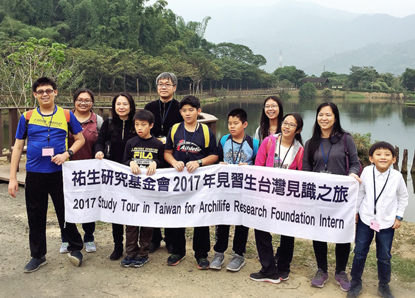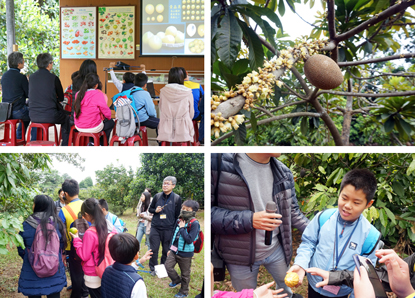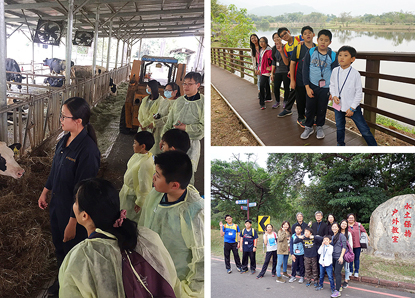Sketch of Archilife Study Tour, December 2017
|
2017年12月份見識之旅縮影  12月份見識之旅活動,於2017年12月9日由呂明澐小姐帶領9位祐生見習生及家長們,進行屏科大熱帶果園參訪暨水土保持教育之旅。活動開始之初,領隊呂明澐小姐提醒本次活動注意事項及觀察重點,先行建立見習生的背景知識。 12月份見識之旅活動,於2017年12月9日由呂明澐小姐帶領9位祐生見習生及家長們,進行屏科大熱帶果園參訪暨水土保持教育之旅。活動開始之初,領隊呂明澐小姐提醒本次活動注意事項及觀察重點,先行建立見習生的背景知識。For the study tour of December 9, 2017, Ms. Lu Ming-yun led nine ARF interns and their parents on a tour to the tropical orchard in NPUST and learned about soil and water conservation. At the start of the day's activities, team leader Ms. Lu Ming-yun reminded everyone about things to note and what to observe, and provided the interns some general background knowledge.  本次行程以屏科大校園為參訪主軸,屏科大為台灣單一校區占地最廣的大學,擁有多樣的生態資源及特殊的學習場域,可供民眾進行環境教學。第一站至熱帶及亞熱帶果樹園參訪,導覽老師說明多年前因與泰國親王簽訂交流合作協議,而以此親王之名,將果園命名為「畢沙迪親王熱帶果園」。接著介紹果園的成立背景及內部栽種的熱帶果樹,並對台灣不常見的熱帶果實,簡述其外觀特徵、口感與食用方式。隨即進入果園參觀,導覽老師主要以當季果實做解說,其中黃金果富含膠質,汁液具黏性,切片後,刀口會殘留難清理的黏液,只要將刀子用火烤過,即可輕鬆將黏液擦去。除了介紹熱帶果實相關知識,亦讓眾人採摘已成熟的果實,品嚐其真實滋味。 本次行程以屏科大校園為參訪主軸,屏科大為台灣單一校區占地最廣的大學,擁有多樣的生態資源及特殊的學習場域,可供民眾進行環境教學。第一站至熱帶及亞熱帶果樹園參訪,導覽老師說明多年前因與泰國親王簽訂交流合作協議,而以此親王之名,將果園命名為「畢沙迪親王熱帶果園」。接著介紹果園的成立背景及內部栽種的熱帶果樹,並對台灣不常見的熱帶果實,簡述其外觀特徵、口感與食用方式。隨即進入果園參觀,導覽老師主要以當季果實做解說,其中黃金果富含膠質,汁液具黏性,切片後,刀口會殘留難清理的黏液,只要將刀子用火烤過,即可輕鬆將黏液擦去。除了介紹熱帶果實相關知識,亦讓眾人採摘已成熟的果實,品嚐其真實滋味。The focus of this study tour was the NPUST campus. With the largest campus on a single site in Taiwan, NPUST has diverse ecological resources and provides special learning place for the public to learn about the environment. The first stop of the tour was a visit to the tropical/sub-tropical orchard. According to the tour guide, the University signed a cooperation agreement with a prince of Thailand many years ago and the orchard was then named H.S.H. Prince Bhisadej Rajani Tropical Orchard. The tour guide also introduced the background of the orchard and its tropical trees, and the appearance, taste and method of eating tropical fruits that are not common in Taiwan. When everyone was inside the orchard, the tour guide explained about seasonal fruits in the orchard. In particular, the Pouteria caimito, has a collagen-rich and sticky pulp. After cutting the fruit, the sticky residue on the knife is difficult to remove. An easy way to remove the sticky residue is to heat the knife over fire before wiping it. Besides learning about tropical fruits, everyone also went to pluck the ripe fruits and savor their tastes.  中午飯後,至畜牧場參訪,為避免人畜疾病共通,眾人皆穿著防護衣入內。在畜牧場人員帶領之下,前往乳牛區,該區主要飼養乳量高、品質穩定的荷蘭乳牛。畜牧場人員特別解釋於健康牛隻胃部開洞,係為了提取富含微生物的胃液,協助其他消化系統出問題的牛隻快速恢復健康。隨後來到肉雞養殖區,畜牧場人員針對場內養殖之烏骨雞做詳細解說,除羽毛呈白色之外,其他部位包含皮、肉、雞冠及腳爪皆是黑色,雞爪為五趾,不同於其他品種僅有四趾。行程最後,前往水土保持戶外教室,首先至靜思湖,導覽人員簡介周邊生態環境及其做為下游滯洪池的功能。緊接著往上游前進,沿途設有跌水溝與箱籠,來降低流速並抵擋水流沖刷,進而防止邊坡崩塌,使水流順利流向滯洪池。藉由認識校園內部的水土保持設施,使見習生們對於水土保持的概念及相關應用,有更深入的了解。至此,本日活動已近尾聲,大家一起合照留念後各自返家,並期待於下次見識之旅再相見。 中午飯後,至畜牧場參訪,為避免人畜疾病共通,眾人皆穿著防護衣入內。在畜牧場人員帶領之下,前往乳牛區,該區主要飼養乳量高、品質穩定的荷蘭乳牛。畜牧場人員特別解釋於健康牛隻胃部開洞,係為了提取富含微生物的胃液,協助其他消化系統出問題的牛隻快速恢復健康。隨後來到肉雞養殖區,畜牧場人員針對場內養殖之烏骨雞做詳細解說,除羽毛呈白色之外,其他部位包含皮、肉、雞冠及腳爪皆是黑色,雞爪為五趾,不同於其他品種僅有四趾。行程最後,前往水土保持戶外教室,首先至靜思湖,導覽人員簡介周邊生態環境及其做為下游滯洪池的功能。緊接著往上游前進,沿途設有跌水溝與箱籠,來降低流速並抵擋水流沖刷,進而防止邊坡崩塌,使水流順利流向滯洪池。藉由認識校園內部的水土保持設施,使見習生們對於水土保持的概念及相關應用,有更深入的了解。至此,本日活動已近尾聲,大家一起合照留念後各自返家,並期待於下次見識之旅再相見。After lunch, everyone went to visit a farm. To avoid diseases that can spread between animals and humans, protective clothing had to be worn. Led by farm personnel, the first place visited was the dairy area where the Holstein Friesian cattle, known for their high milk production and stable quality, were raised. Farm personnel explained that they opened a small hole in the stomach of healthy cattle to extract gastric juice rich in microorganisms so as to help other cattle with digestive problems to restore their health quickly. Next, everyone moved to the poultry area. Farm personnel explained that although the silkie chicken has white plumage, its other body parts are black, including skin, flesh, crest and feet. Moreover, it has five toes on each foot instead of four. In the final part of the tour, everyone visited the soil and water conservation outdoor classroom. Stopping at the lake, the tour guide briefly introduced the surrounding ecological environment and the lake's function as a downstream detention basin. Along the upstream banks are drainage ditches and gabion, which slow water flow and scouring, and thus preventing the slope from collapsing and water can flow smoothly toward the detention basin. Through the soil and water conservation facilities in the campus, the interns developed a deeper understanding of the concept and applications of soil and water conservation. At this point, the day's itinerary came to an end. Everyone returned to home after taking a group photo and looked forward to the next study tour. |

